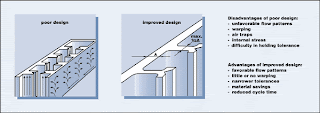Just as metals have normal working thickness ranges based upon their processing method, so do plastics. Typically, for injection molded parts, the wall thickness will be in the range 0.5 mm to 4 mm (0.02 - 0.16 in). Dependent on the part design and size, parts with either thinner or thicker sections can be molded.
| While observing functional requirements, keep wall thicknesses as thin and uniform as possible. In this way even filling of the mold and anticipated shrinkage throughout the molding can be obtained in the best way. Internal stresses can be reduced. Wall thickness should be minimized to shorten the molding cycle, obtain low part weight, and optimize material usage. The minimum wall thickness that can be used in injection molding depends on the structural requirements, the size and geometry of the molding, and the flow behavior of the material. As a starting point the designer can often refer to spiral flow curves which give a relative measure of the maximum achievable flow length for a given wall thickness and injection pressure. See figure below. Spiral flow length of Akulon Ultraflow at 260° and 1400 bar. |
If parts are subjected to any significant loading the part should be analyzed for stress and deflection. If the calculated stress or deflection value is not acceptable a number of options could be considered including the following:
Insulation characteristics Generally speaking insulating ability (whether for electrical or heat energy) is related to the thickness of the polymer. Impact characteristics Impact resistance is directly related to the ability of a part to absorb mechanical energy without fracturing. This in turn is related to the part design and polymer properties. Increasing the wall section will generally help with impact resistance but too thick (stiff) a section may make a design unable to deflect and distribute an impact load therefore increasing stresses to an unacceptable level. Agency approval When a part design must meet agency requirements for flammability, heat resistance, electrical properties etc, it may be necessary to design with thicker sections than would be required just to meet the mechanical requirements. Where varying wall thicknesses are unavoidable for reasons of design, there should be a gradual transition (3 to 1) as indicated in the figure below. Gradual transition of wall thicknesses. |
| Generally, the maximum wall thickness used should not exceed 4 mm. Thicker walls increase material consumption, lengthen cycle time considerably, and cause high internal stresses, sink marks and voids (see figure below). Sink marks due to large wall thicknesses. |
| Voids due to large wall thicknesses. |
| Care should be applied to avoid a "race tracking" effect, which occurs because melt preferentially flows faster along thick sections. This could result in air traps and welds lines, which would appear as surface defects. Modifying or incorporating ribs in the design can often improve thick sections. Influence of rib design on flow behavior of the melt. |
| Example of design study of multi-connector. |






I really like your post. Thanks for sharing such a informative blog. Keep posting and upgrading our knowledge.
ReplyDeleteMagnamike 8600
Hi..
ReplyDeleteI appreciate your Informative post and thanks for sharing.
MagnaMike 8600 – Bottle Thickness Gauge
Hi..
ReplyDeleteI appreciate your Informative post and thanks for sharing.
Wall Thickness Gauge 8600
laser cut PerspexThank you for sharing this.
ReplyDeleteOur manufacturing facility is equipped with high power state-of-the-art German Rofin laser cutting which is the pinnacle of technology in terms of precision, quality and performance. Our Laser machine cuts acrylic up to 20 mm thick.
laser cut Perspex